3 Seasonal Cocktail Recipes to Try This Fall
With the first cool breeze of fall, you might start craving spicy, comforting drinks instead of your usual glass of white wine or craft beer. Need the perfect cocktail for a chilly evening? We rounded up our favorite seasonal flavors (like cinnamon, maple, and apple) and added a few pours of booze and a squeeze of citrus.
Pull out your coziest sweater and stock your bar cart with bourbon, ginger beer, and cider. Let’s do this!
1. Maple hot toddy
A chilly fall evening with a hot toddy in one hand and the edge of a blanket in the other? Sign us up. Just swap the traditional honey as the drink’s sweetener for the more seasonally appropriate maple syrup.
No bourbon? Any ol’ whiskey will do.

Ingredients
- 1/2 cup water
- 2 ounces bourbon
- 1/2 ounce lemon juice
- 1 teaspoon maple syrup
- Lemon wedge
Instructions
- Bring water to a boil.
- Combine bourbon, lemon juice, and maple syrup in a heat-safe cup, jar, or mug.
- Pour hot water over bourbon mixture.
- Garnish with lemon.
2. Cider punch
Remember chugging all the apple cider in sight the moment it appeared in front of you as a kid? You’re about to experience the grown-up version of that excitement (but maybe don’t gulp this one down).
No hard cider on hand to top the drink? Any sparkling wine will do, as will club soda or sparkling apple cider.
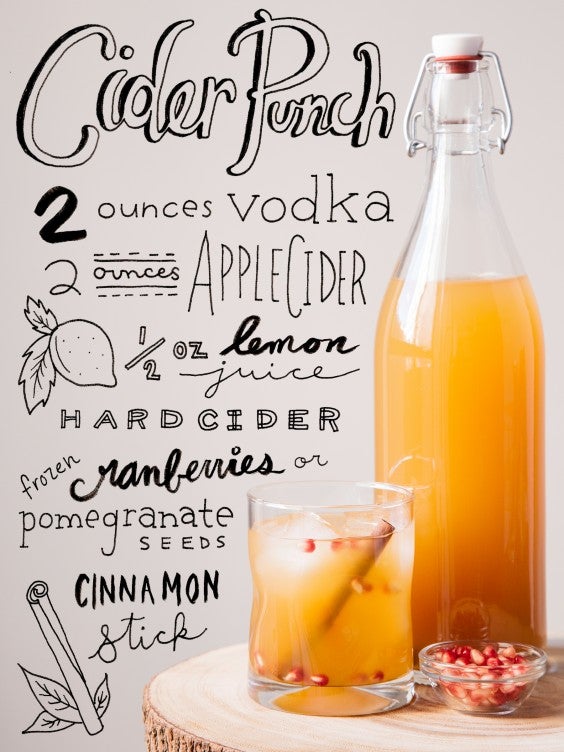
Ingredients
- 2 ounces vodka
- 2 ounces apple cider
- 1/2 ounce lemon juice
- Hard cider
- Frozen cranberries or pomegranate seeds
- 1 cinnamon stick
Instructions
- Fill a glass with ice.
- Pour vodka, apple cider, and lemon juice over ice.
- Fill the rest of the glass with hard cider.
- Garnish with frozen cranberries and cinnamon stick.
3. Cranberry-ginger gimlet
Tart, bubbly, and a bit spicy at the end, this cranberry-ginger gimlet is like a Cosmo gone fall-ish. You can use gin instead of vodka in a pinch, but don’t try to sub cranberry juice cocktail for real juice. (Seriously.)

Ingredients
- 2 ounces orange vodka
- 1 teaspoon Cointreau (Buy a cheap tiny bottle from the liquor store counter.)
- 1/2 ounce lime juice (Just squeeze 1/2 of a lime.)
- 1/2 ounce unsweetened cranberry juice
- Ginger beer
- Lime wedge
Instructions
- Fill a cocktail shaker with ice.
- Pour in vodka, Cointreau, lime juice, and cranberry juice and shake well.
- Pour into a martini or coupe glass (though, really, any glass will do) and top with ginger beer.
- Garnish with lime.
from Greatist Health RSS Feed https://bit.ly/3GwgxFo
More Kettlebell: 15 Killer Benefits of Kettlebell Swings
Whether you’re a gym newb or a seasoned CrossFitter, you can benefit from adding kettlebell swings to your strength training routine. This ultimate all-in-one workout helps with everything from spine strength and hip flexibility to cardio and calorie burn.
So, how can one little piece of equipment do so much for your body? Let’s break down the benefits of kettlebell swings — plus how to safely add kettlebell swings to your existing workout.
What are the benefits of kettlebell swings?
Kettlebell swings are good for pretty much everyone because they:
- Build muscle
- Provide a full-body workout
- Boost your cardio fitness
- May help with weight loss
- Strengthen weak muscles
- Are easy on your back
- Build functional strength
- Improve your posture
- Are super convenient
- Improve your flexibility
- Boost your balance
- Build power and athleticism
- Improve heart health
- Are low impact
- Are versatile and approachable

Kettlebell swings: A history
Kettlebell swings are one of many exercises you can do with a kettlebell. This type of free weight looks like a cannonball with a handle and is usually made of cast iron or steel.
Kettlebells come in a variety of sizes and can be used for presses, cleans, swings, curls… really any move you can do with dumbbells or a barbell.
The kettlebell swing is thought to have originated in 18th-century Russia, where folks started lifting counterweights for fun. You’ll often find kettlebells measured in Russian poods (~16 kilograms or 36 pounds), and the classic kettlebell swing is also known as the Russian kettlebell swing (the more you know… 💫).
How to do kettlebell swings for max benefits
The two-handed Russian swing is an ideal entryway into kettlebell exercises. Here’s how it’s done:

- Stand straight and tall with your feet about shoulder-width apart. Hold the kettlebell in front of your body with both hands.
- Engage your core, squeeze shoulder blades together, and keep arms long and loose.
- Bend knees slightly, shift your weight into your heels, and push hips back.
- Drive through your heels and explode forward with your hips. Squeeze core and glutes as you thrust your hips to help you swing the kettlebell to chest height, with arms extended.
- Make sure you keep your upper body relaxed as you swing. Avoid lifting the weight with your arms and instead push with your hips and let the kettlebell swing from your shoulders.
- Shift hips back as the kettlebell descends (like pushing your hips to the wall behind you). Hinge at your hips, letting hamstrings and glutes carry the weight.
- Let the kettlebell gently swoosh back between your legs.
- Drive through hips and heels to repeat. Your arms should act as a pendulum that the kettlebell swings from.
Safety first!
To prevent injuries and accidents, keep these tips in mind:
- Don’t swing too high or low. Swing the kettlebell to shoulder height or below.
- It’s all in the hips. Power the swing with your legs and hips, not your arms! Think of it as a thrust, NOT a squat.
- Don’t lean back. Keep your core tight to avoid getting bendy and straining your lower back.
15 benefits of kettlebell swings
So, why add this exercise to your next workout? Here’s how kettlebell swings can up your fitness game.
1. Build muscle
New lean muscle mass, who dis? Kettlebell swings are a form of weightlifting that can help you build muscle.
Like barbell and dumbbell workouts, kettlebell swings are a type of anaerobic activity that uses a bunch of energy in a short amount of time to help you get buff.
A small 2013 study also found that a 10-week kettlebell training program helped improve power and strength for weightlifting and powerlifting.
2. Provide a full-body workout
So, what muscles are you actually working? Kettlebell swings work your entire posterior chain in one fell swoop. This series of large muscles runs from your neck to your heels on the back of your body, including upper- and lower-body muscles like your:
- deltoids
- traps
- pecs
- glutes
- hamstrings
3. Boost cardio fitness
Why do strength training and cardio when you can do both at once? Research suggests kettlebell swings may help increase your aerobic fitness — the way your body uses oxygen to increase breathing and heart rate.
A 2010 study of athletes performing 12 minutes of kettlebell swings found that the workout was more challenging for the cardiorespiratory system than traditional circuit weight training. The authors concluded that this style of kettlebell workout can improve cardiorespiratory fitness.
Another 2012 study found that folks performing kettlebell swings and treadmill running had similar average heart rates and ratings of perceived exertion.
Research from 2014 also found that kettlebell swings produced a greater cardiovascular response than Tabata or traditional resistance training.
4. Help with weight loss
If you’re on a weight loss journey, kettlebell swings can help you burn fat and build muscle at once. The folks at the American Council on Exercise (ACE) believe kettlebell workouts may help you burn twice as many calories as other strength training exercises.
According to ACE’s 2010 research, kettlebell workouts can burn a whopping 20.2 calories per minute, which is equal to what most peeps would burn running at a 6-minute mile pace.
5. Strengthen weak muscles
Sitting at a desk all day can tighten up your hip flexors and weaken your back. And if you’re already lifting weights, most workouts target only the front of your body, which can lead to muscle imbalances.
Kettlebell swings can help you loosen up your hips and strengthen any weak posterior muscles like your glutes, hammies, and lower back.
6. Go easy on your back
While more research needs to be done before we can declare that kettlebell swings can cure back pain, the exercise may be a relatively low impact way to build strength and mobility in your back.
According to a small 2012 study, kettlebell swings may create strain on the spine in the opposite direction of traditional lifts. This *might* be why some folks think kettlebell swings help improve their back function and health.
A 2017 study on hip and low back pressure pain thresholds found that folks performing kettlebell swings had reduced muscle sensitivity in that area.
This doesn’t prove that the workout reduces back pain, but researchers noted it’s worth looking into how kettlebell swings could help with low back pain or muscle soreness after a workout.
7. Build functional strength
Kettlebell swings strengthen parts of your body you use every day. Gripping the handles of a kettlebell during swings or any other kettlebell exercise can help improve your grip strength.
Plus, the swinging motion creates a functional movement pattern that mirrors bending down and lifting. Because you’re working those posterior muscles, you’ll be nice and strong for everyday lifting and bending.
8. Improve your posture
To do a kettlebell swing properly, you’ll need good posture throughout — and you can carry that into other workouts and everyday life.
When you properly perform a kettlebell swing, you keep your spine straight, your core and glutes engaged, and your pelvis neutral. Instead of straining your back, this simple adjustment can help train your bod to use your core and hinge at the hips (hello, functional strength!) for excellent posture.
9. Convenient AF
Kettlebell swings don’t require a gym membership or clunky equipment. You can simply keep some kettlebells in your living room or home gym.
You can easily perform kettlebell swings while you watch TV for a quick cardio and strength training workout. No treadmill or gigantic home gym setup required.
10. Improve flexibility
We’re not saying to skip your stretching routine, but thanks to working that posterior chain, kettlebells may help you get bendy.
The swinging motion and hip thrusting used in kettlebell swings can open up your hips, elongate your spine, and strengthen your back muscles to create more flexibility.
11. Boost your balance
Good balance isn’t just for ballerinas — it’s for anyone who wants to avoid tripping over their own feet.
In a small 2013 study, participants who worked out with kettlebells twice a week for 8 weeks showed improvements in dynamic leg balance.
A small 2020 study also found that ballerinas who completed kettlebell training (including swings and get-ups) improved jump performance and balance more than dancers who took traditional jump and balance dance classes.
We need more research to know just how effective kettlebell swings are for balance, but they *might* help you hold those tricky yoga poses.
12. Build power and athleticism
The kettlebell swing’s explosive movement mimics many of the motions needed to run, lift, or jump effectively. According to a 2012 study, kettlebell swings can improve explosive strength.
Basically, this is a total power move. So if you want to boost your athletic prowess, kettlebells swings can help.
13. Improve heart health
You probably already know that cardio can benefit heart health thanks to its ability to use oxygen and boost your heart rate. Since kettlebell swings count as cardio, they can keep your heart going strong too.
A small 2021 study found that kettlebell exercises may also help lower blood pressure, but more research is needed in this area.
14. Low impact
Traditional barbell training or high intensity interval training (HIIT) workouts can subject your joints to extreme pressure and loads that you won’t find with kettlebell swings.
So if you’re dealing with injuries or weak joints, kettlebell swings can provide a low impact strength training option.
15. Versatile and approachable
Compared to other strength training exercises, kettlebell exercises like the swing may be safer and more versatile across ages and skill sets. (Plus, they’re way less scary than powerlifting if you’re new to resistance training.)
In a 2021 study of 35 adults (men and women ages 59 to 79), researchers found that 17-pound kettlebell swings had a similar effect to 52-pound deadlifts. As a result, the authors suggest that kettlebell swings may be an “easier, more convenient, and more appealing” option.
Though the study sample size is small, really anyone can benefit from using kettlebells.
How will kettlebell swings benefit *your* fitness?
- Yogis can gain flexibility and strength.
- Weightlifters can increase power and conditioning.
- Runners can up their cardio fitness in a low impact way.
- CrossFitters can improve functional strength and power.
- Newbies can get an all-in-one cardio and strength training workout with minimal equipment.
How to take kettlebells for a swing
Here’s how to get started with kettlebell workouts:
- Choose your weight. To stay safe and prevent injury, pick a weight that’s challenging but not so heavy that it wrecks your form. If you’re a kettlebell beginner, manufacturers often recommend women start with about 18 pounds (8 kilograms) and men start with 35 pounds (16 kilograms). Over time, you can slowly work your way up to heavier weights.
- Pick your kettlebell. Not sure where to kick-start your kettlebell shopping list? Check out our recs for the best OG kettlebells and adjustable kettlebells if you’re tight on space.
- Start strength training. Add kettlebell swings to a weightlifting plan twice a week. Start with 2–3 sets of 10 reps. As you get more comfortable with the move, you can add more reps.
- Try HIIT. Complete kettlebell swings for 20 seconds, followed by 10 seconds of rest. Repeat for up to 8 sets and you’ve got yourself a HIIT routine.
- Add a warmup. You can also use lighter weights (kettlebells come in 4-kilogram increments) as a warmup or activation exercise before other lifting routines.
Craving more kettlebell? Try these workouts
There’s a lot more to kettlebells than just the basic swing. Here are a few more workouts to try:
The takeaway
Kettlebell swings are an effective all-in-one cardiovascular and strength training exercise. Doing the exercise regularly may provide a number of benefits like muscle growth, weight loss, and better balance.
If you’re new to kettlebell swings, start with a weight that’s challenging but still lets you maintain good form and perform 2–3 sets of 10 reps just twice a week.
from Greatist Health RSS Feed https://bit.ly/3mnL1Bs
Chew on These Facts: 9 Benefits of Chewing Gum
Depending on who’s chomping, chewing gum can be seen as a lifestyle or a habit. But could all that gum chewing actually be good for you?
Whether you’re a Stride Stan or a Doublemint devotee, there are actually some legit benefits of chewing gum.
What are the benefits of chewing gum?
There is some evidence that chewing gum has benefits like:
- Reducing stress
- Boosting memory
- Improving oral health
- Preventing ear infections
- Helping you quit smoking
- Helping the gut heal after surgery
- Relieving reflux symptoms
- Satisfying thirst
- Seeing more clearly
Gum gets weird: What’s it actually made of?
You thought that gum under your fifth grade desk was old? Chewing gum is likely an ancient practice that started with folks chewing gum made from tree sap.
Today, chewing gum is made from these (mostly) man-made ingredients:
- Elastomers. Synthetic rubber-like substances that make gum chewable.
- Resins. Plant-based or synthetic ingredients added to help gum stay together.
- Waxes or oils. Help make gum soft and chewable when warmed.
- Fillers. Ingredients like calcium carbonate or talc can help add texture.
- Flavoring. Natural or artificial ingredients that give it that signature minty or fruity taste.
- Sweeteners. Gum may be sweetened with natural sugars or sugar substitutes like aspartame, stevia, or sugar alcohols.
9 health benefits of chewing gum
It probably seems odd that chewing on a bunch of food-grade synthetic ingredients could be good for you. But science shows a number of ways certain ingredients and the actual chewing part may help your health.
1. Reduces stress
Ever reached for gum during a marathon study sesh — or an actual marathon? It might be because chewing helps lower stress levels. A small research review of 20 studies on chewing gum and stress found evidence that gum reduced stress for people in work and educational settings.
In a study of 100 students, researchers found evidence to support that chewing gum before exams helped students’ stress and test scores.
2. Boosts memory
Chewing gum has been linked to better cognition and memory, and a study with magnetic resonance imaging (MRI) tests found that chewing gum activates the part of the brain associated with memory.
But experts said further research is needed to determine whether chewing gum could prevent memory loss or improve memory in people with brain injury.
3. Improves oral health
Chewing gum can actually be good for your teeth (just make sure it’s sugar-free!). Chewing sugar-free gum after you eat can help clean food off your teeth, increase salivation to fight plaque, and rebuild enamel.
There’s also evidence gum containing xylitol (a sugar alcohol used to sweeten gum) changes the bacteria in your mouth. In a small study with 70 Japanese men, researchers evaluated the effect of chewing gum with xylitol on microorganisms in the men’s saliva. The group who chewed gum with xylitol had a significantly lower number of bacteria in their saliva than the control group.
4. Prevents ear infections
Yeah chewing gum can help pop your ears on an airplane, but it’s actually the ingredients, not the act of chewing, that may help ear infections.
Remember that sugar alcohol xylitol? Xylitol has actually been studied as a preventative for ear infections in children. Whether given to kids in a chewing gum, lozenge, or syrup, a research review found that xylitol seemed to help prevent bacterial infections via Streptococcus pneumoniae and Haemophilus influenzae that can lead to inner ear infections. But researchers also noted we need larger studies to know for sure, and it only seemed to benefit already healthy kiddos.
5. Helps you quit smoking
Though a regular piece of Hubba Bubba may keep your mouth occupied while you’re quitting cigarettes, there are better gums for the job.
A 2013 research review showed that nicotine replacement therapy, which includes the use of nicotine gum, is 80 percent more effective at helping people quit smoking than the placebo. Using two forms of nicotine replacement therapy is even more effective.
6. Helps your gut heal after surgery
Abdominal surgery can be rough on your digestion. There’s evidence that chewing gum can kick-start your sluggish bowels.
According to a small research review of 10 studies (including 1,659 participants), chewing gum improved the recovery of intestinal function after having a cesarean delivery, commonly referred to as a C-section. Chewing gum also seems to help people recover from colon surgery.
7. Relieves heartburn
Pop some gum after meals to ease indigestion and the dreaded burn. Because chewing gum increases the flow of saliva, it can help wash down digestive acid and improve reflux symptoms.
8. Satisfies your thirst
There’s no substitute for drinking water, and chewing gum won’t actually improve your body’s hydration. But there is some evidence that it can make you feel less thirsty in a pinch.
A small research review of 12 studies found that the increase in saliva from chewing gum helped relieve thirst and dry mouth. Still, keep drinking that H20.
9. Helps you see more clearly
OK, we’ll be honest. We need more info to prove the chewing gum and sight connection. But in a small study with 46 adults, researchers found that chewing gum improved eye focus.
You’ll still want to reach for your glasses instead of a pack of gum.
Are there any drawbacks to chewing gum?
Many sugar-free chewing gums earn the ADA Seal of Acceptance, which means it is considered safe by dentists.
But always check those ingredients! Chewing gum with sugar may increase the risk of cavities, so sugar-free gum is a better bet for your chompers.
Gum containing acids like citric acid may also lower plaque pH and help erode enamel. Sugar alcohols like xylitol may also cause digestive distress if consumed in large amounts (so probs don’t swallow that gum).
How to choose the best chewing gum
Here are some tips for picking the best gum for you:
- Keep it sugar-free. None of the benefits above are worth extra dentist duty.
- Pick a flavor that you like. It can’t help much if you don’t want to chew it.
- Look for xylitol. Its antibacterial properties can do wonders for your mouth, and dentists like it. (But don’t go overboard, it may be rough on your tummy.)
The takeaway
Chewing sugar-free gum is basically harmless and might have some health benefits, like improving digestion and lowering stress levels. At the very least, it helps keep your teeth clean and your mouth healthy.
from Greatist Health RSS Feed https://bit.ly/3mqNDOX
12 Dairy-Free Recipes That Are Just as Rich as the Real Deal
Cutting out dairy can seem next to impossible when you think about the foods you’ll have to give up, from cheesy slices of pizza to ice cream and cheese plates.
But as dairy-free diets have grown in popularity, it’s become easier and easier to find substitutes to use when cooking or snacking. With the right shopping list, dairy-free doesn’t have to be a drag. Promise.
These dairy-free recipes use everything from nutritional yeast to coconut milk to mimic the rich, creamy, or savory taste you want without any of the lactose or animal byproducts you may be trying to avoid.
1. Vegan kale Caesar salad
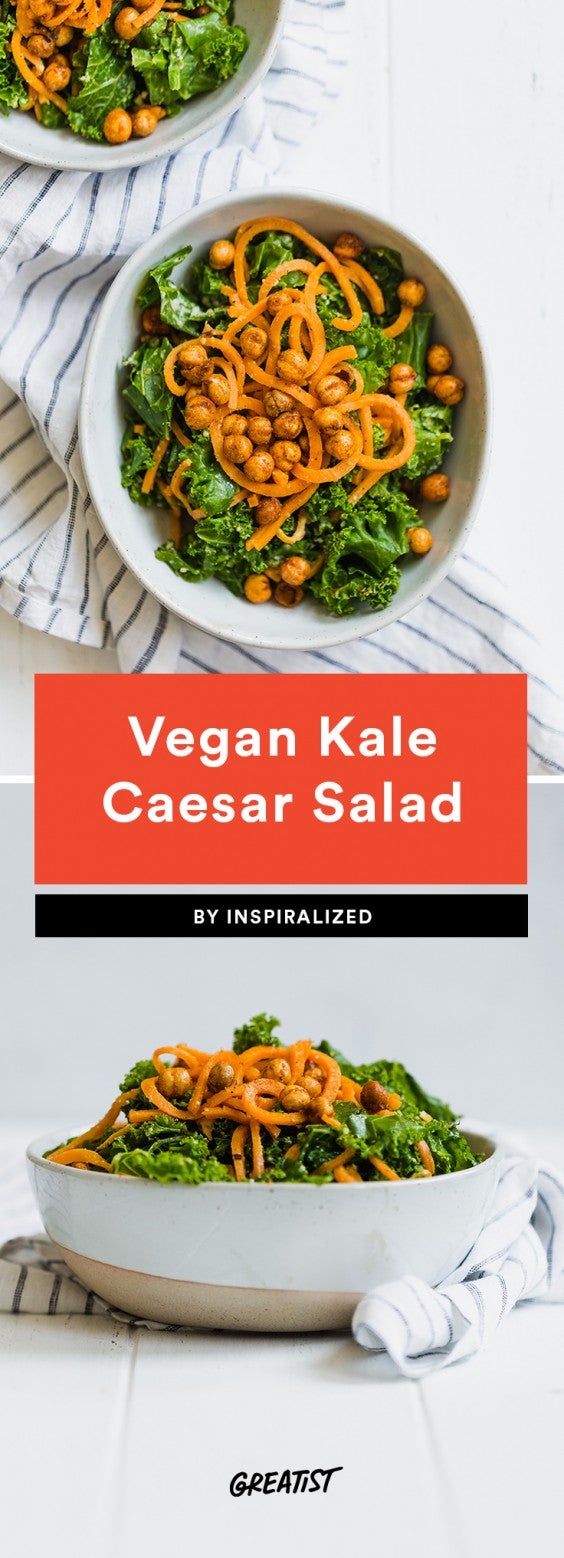
Love a good Caesar salad? You can still have one without a speck of Parm or mayo in sight. Make a dressing out of soaked cashews, almond milk, garlic, lemon juice, and Dijon and toss it with fresh kale and spicy chickpeas. Add some sweet potato noodles on there for a more filling meal and you’ll be good to go.
2. Dairy-free pumpkin creamer
We can score a homemade PSL without the lactose? Say more. We’re all for pumpkin flavors all year round, so add this tasty dairy-free creamer to your morning routine.
3. Creamy Mounds smoothie
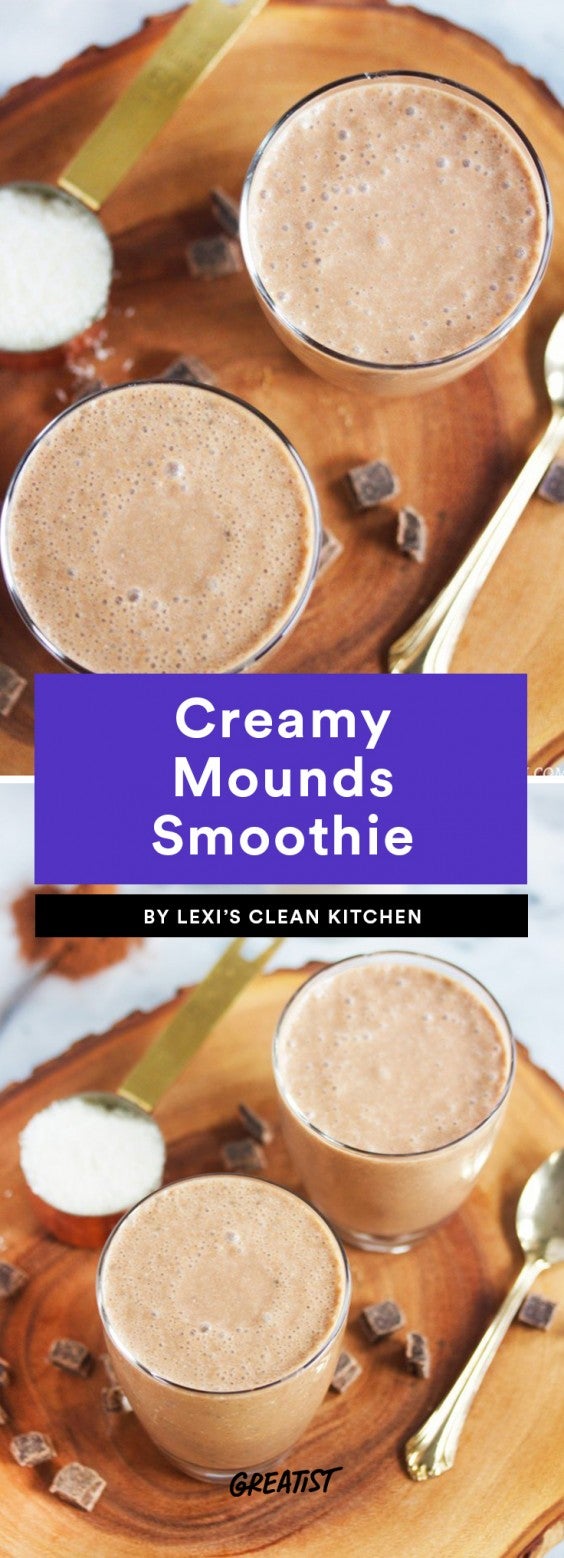
When you’re craving a milkshake, blend up this smoothie. Cashew milk is a little thicker than almond, so it’s ideal to use here. Mix it with banana, chia seeds, coconut flakes, cauliflower, and some cocoa powder and full-fat coconut milk.
You’ll feel like you’re drinking a Mounds candy bar, in the best way (with some sneaky veggies for added nutrients!).
4. Dairy-free herbed scalloped potatoes
There’s nothing more comforting than potatoes, unless we’re talking scalloped potatoes upping the ante. We’ll gladly eat them all year round, not just on holidays.
A bit of dairy-free butter, your dairy-free milk of choice, a whole bunch of russet potatoes, and you’re golden… literally. You could even add some nutritional yeast for an even more cheesy bite.
Snag the recipe for your table.
5. Creamy pasta with basil and kale
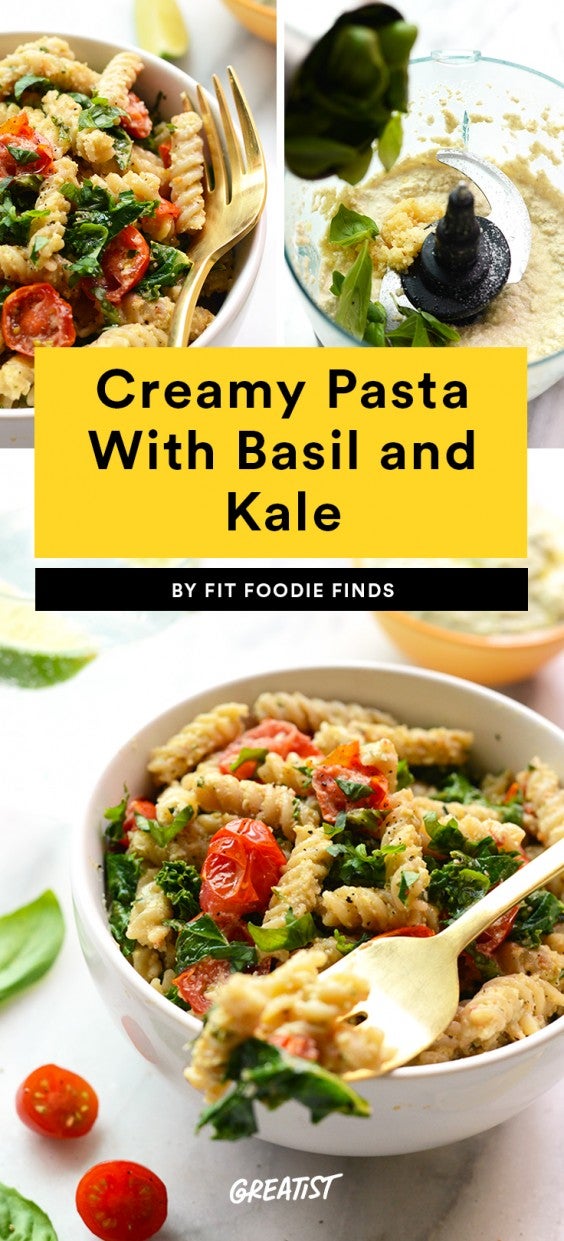
Creamy pasta IS possible to make dairy-free, even if it’s not quite the same as a bowl full of mac and cheese. Again, cashews are your friend here, so whip out your food processor and blend ’em up with some fresh basil, olive oil, and garlic.
Add some color to your dinner with kale and cherry tomatoes. And if you’re not vegan, feel free to sneak some leftover grilled chicken or sausage in there.
Grab the recipe for your meal prep here.
6. Vegan spinach artichoke dip
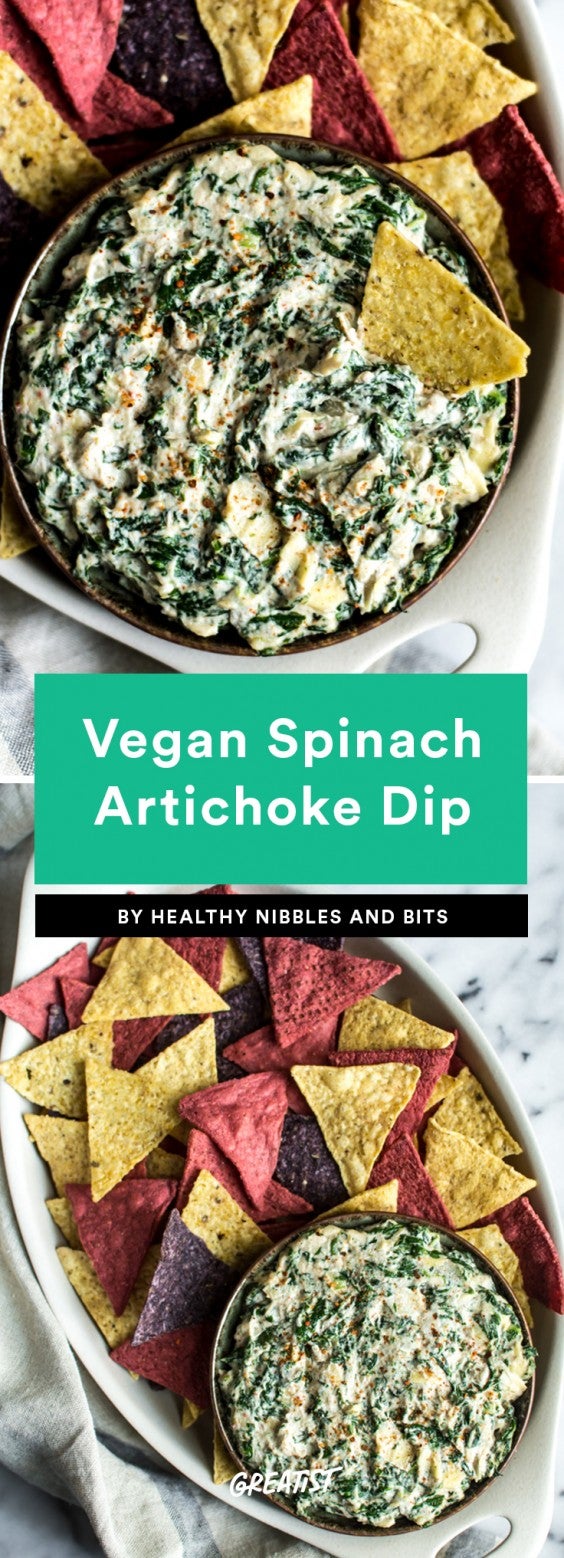
If you’re worried about avoiding the endless dips and quesos bound to be at this year’s Super Bowl party, it’s time to break out this dairy-free dip. It’s just as satisfying as the real thing and won’t make you feel as blah after a few bites. More room for wings!
Learn the steps to make it here.
7. Dairy-free naan
Naan flatbread is often made with yogurt, ghee, or butter, so it’s not always dairy-free. But this recipe needs no milk products to make the savory, soft texture we know and love. We’d recommend adding the optional garlic, but it’s your call.
Grab the recipe for your next dinner party.
8. Sausage tomato basil pizza

The downside of dairy-free cheese is that it tends to be a little more expensive than the regular kind, so dumping an entire bag of shreds on a pizza might hurt your heart a little. The solution: Make the toppings the star and add a little nutritional yeast to the sauce to give it a bit of that cheesy flavor while keeping it dairy-free.
9. Chicken broccoli Alfredo bake

Casseroles are our favorite, considering all you have to do is mix everything up and toss it in a baking dish. This one tastes like Alfredo pasta and uses coconut milk, nutritional yeast (it’s really a savior), chicken, and broccoli. The “pasta” part is actually spaghetti squash, so you’re getting a big heap of veggies with each serving too.
10. Almond Joy ice cream
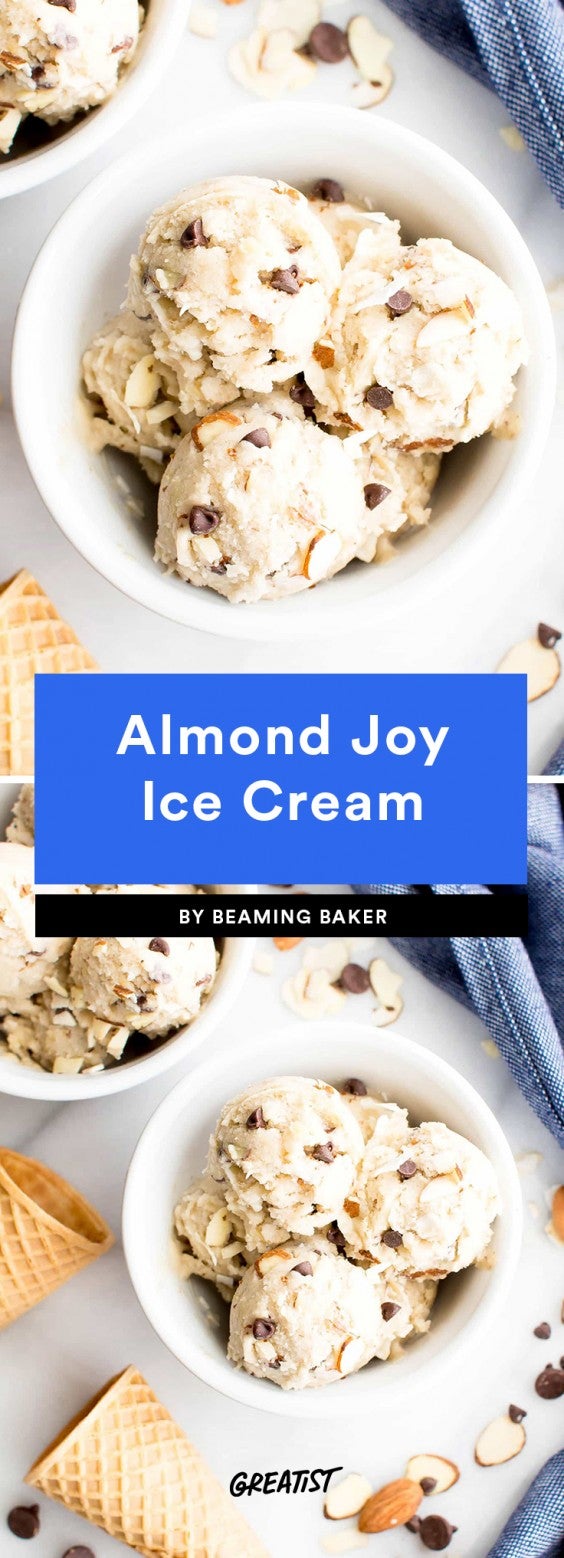
Don’t think we forgot about dessert. While everyone from Halo Top to Ben & Jerry’s has come out with a dairy-free pint in the last few years, you can easily make your own for a fraction of the cost. This one tastes like a cross between Chunky Monkey and an Almond Joy. Get excited.
11. Apple upside-down cake
This light and fluffy apple upside-down cake is not only dairy-free but also eggless and vegan. Plus, the look of those layered sliced apples is just so pretty on a table. Save this one for some guests (or just eat it yourself on a chilly night).
12. Dairy-free cheesecake
Even the beloved cheesecake can have a dairy-free makeover using coconut cream, vegan cream cheese, and good ol’ cashews. Plus, the crust is made with golden Oreos, which are dairy-free and vegan. The more you know.
Here’s how to get cheesy with it.
from Greatist Health RSS Feed https://bit.ly/3CrWsOc
11 Zesty Perks of Lemongrass Essential Oil
Lemongrass is a stalky grass with a fresh, citrusy flavor that’s commonly used in Southeast Asian cuisine (Thai food, anyone?). But when you’re not eating some delish lemongrass chicken, the herb also makes a stellar essential oil that can be used topically or inhaled.
Here’s a deep dive into the possible health benefits of lemongrass essential oil, plus how to use it safely.
While research suggests there are health benefits, the FDA doesn’t monitor or regulate the purity or quality of essential oils. It’s important to talk with your healthcare provider before you begin using essential oils and be sure to research the quality of a brand’s products. Always do a patch test before trying a new essential oil.
What are the benefits of lemongrass essential oil?
As with many essential oils, we need a lot more information to find out more about the effects of lemongrass essential oil. But research has looked into a number of possible health benefits, including:
- Antibacterial properties
- Antifungal properties
- Anti-inflammatory properties
- Pain relief
- Antioxidant properties
- Improved digestive health
- Diarrhea relief
- Reduced cholesterol
- Blood sugar regulation
- Stress and anxiety relief
- Headache and migraine relief
Benefits of lemongrass essential oil
Lemongrass essential oil might offer some bomb benefits for your mind and body. Here are 11 ways it could help your health.
1. Antibacterial properties
Lemongrass essential oil has some pretty dope antibacterial properties.
A 2016 test-tube study found that it could fight off Acinetobacter baumannii, a type of bacteria that can cause infections in the urinary tract, blood, and lungs (pneumonia). But more studies on humans are needed to find out just how well it works.
2. Antifungal properties
A 2014 test-tube study found that lemongrass essential oil was effective against Candida albicans, C. tropicalis, and Aspergillus niger fungi. This means it might help fight fungal infections IRL. But we need more human studies to find out more about all the fungus-fighting effects.
(BTW, Candida albicans is the mastermind behind yeast infections and thrush. Ugh! But *please* don’t put essential oil up your vajayjay. It can be irritating and might make the infection worse.)
3. Anti-inflammatory properties
Lemongrass contains compounds called citral and geranial that are thought to have anti-inflammatory properties.
In a 2014 animal study, researchers found that oral lemongrass essential oil helped reduce inflammation in mice with carrageenan-induced paw edema. The same study also found that a topical solution of the oil reduced inflammation in mice that had ear edema.
But we def need more research to find out whether these effects would occur in humans. And it’s important to note that, unlike the rats in this study, you should never ingest essential oils.
4. Pain relief
Since lemongrass might help calm inflammation, there’s also a chance it could reduce pain.
In a small 2017 study, daily topical lemongrass oil use helped decrease pain levels in folks with rheumatoid arthritis. Generally, pain levels decreased from 80 to 50 percent within the 30 days.
While this is great news, we need more studies to find out whether these pain relief powers are the real deal.
5. Antioxidant properties
Lemongrass essential oil might have some top-notch antioxidant properties.
One 2015 study found that lemongrass mouthwash had strong antioxidant effects. That means it might make a good complementary therapy for folks who have gingivitis or other oral health probs.
According to another 2015 study, lemongrass helped hunt down free radicals in an in-vitro environment.
The bad news? We still need more studies to show how it works and what concentrations are the most effective.
6. May help digestive health
Some anecdotal evidence suggests lemongrass can help reduce nausea, pain, bloating, and cramping caused by a variety of gastrointestinal conditions.
While a 2012 study found that lemongrass essential oil helped prevent gastric ulcers in mice, we still need more human studies to find out whether this is a legit benefit.
7. May treat diarrhea
Diarrhea stinks 💩. Thankfully, lemongrass might help get your bowels back on track.
According to research from 2011, the plant has some pretty sweet antidiarrheal effects. But we need more studies to find out whether it can really stop the trots.
Also, researchers are still trying to figure out the best way to take lemongrass as a tummy treatment (e.g., through inhalation, tinctures, or tea).
8. May reduce cholesterol
Lemongrass oil might help your heart health. A 2011 study on rats found that lemongrass oil could reduce hyperlipidemia (high levels of fat particles in the blood).
A 2007 study found that lemongrass oil reduced cholesterol in rats that were fed a high cholesterol diet for 2 weeks. But the researchers fed the oil to the rats orally, and ingesting essential oils is not recommended for us humans. If you’re concerned about your cholesterol levels, consult a healthcare pro to find a safe treatment.
And keep in mind that we need more research on the potential effects of lemongrass oil for cholesterol in humans.
9. Might help regulate blood sugar
Lemongrass oil might help reduce blood sugar levels in folks with type 2 diabetes, according to a 2007 animal study. The researchers gave 125 to 500 milligrams of lemongrass oil to rats orally for 42 days and found that it helped lower blood sugar levels and increase HDL (good) cholesterol levels.
But this isn’t cold, hard proof that lemongrass alone can help regulate blood sugar. And again, please don’t try this at home — ingesting essential oils can be dangerous and is not recommended.
10. Stress and anxiety relief
Some folks use lemongrass essential oil as a way to calm down. It’s a popular addition to aromatherapy, mindfulness, and yoga practices. There’s also a chance it can increase the anti-stress benefits of massage therapy.
A 2015 study examined the use of sweet almond and lemongrass oils during massage. Participants who received a massage with the oil once a week for 3 weeks had lower diastolic blood pressure than those who didn’t. This might suggest a reduction in stress levels, but we need more studies to find out for sure.
11. Headache and migraine relief
Lemongrass might help a pounding head. One 2011 study found that native Australian lemongrass could help relieve headache and migraine pain. The researchers noted that a compound called eugenol might be the reason, thanks to its aspirin-like effects. But once again, we need more concrete proof.
Lemongrass essential oil side effects
Diluted lemongrass oil is generally recognized as safe by the Food and Drug Administration. But there are still some side effects to watch out for.
For one thing, high doses can be poisonous. It can also be super toxic to kids and pets. And we’ll say it again: You should *never* ingest essential oils.
Lemongrass oil can also have some not-so-nice skin symptoms. Some folks experience a rash, itching, hives, blistering, or redness. Here are some tips to minimize your risks:
- Don’t apply it to broken or damaged skin.
- Dilute lemongrass essential oil with a carrier oil before use.
- Stick to high quality oils that don’t contain added fillers or fragrances.
- Avoid using it if you have sensitive skin or a condition like eczema or psoriasis.
How to use lemongrass essential oil
Here’s how you can safely use lemongrass as an aromatherapy or topical treatment.
Lemongrass essential oil for inhalation
You can experience the aromatherapy benefits of lemongrass essential oil by inhaling its scent via any of these methods:
- Add a few drops to an essential oil diffuser.
- Add a few drops to a bowl of warm water and inhale the steam.
- Sprinkle a few drops on a handkerchief or cotton ball and breathe it in.
Lemongrass essential oil for topical use
You can buy a pre-diluted bottle of lemongrass oil at health-food stores or online. But you can also DIY it.
Just add up to 12 drops of essential oil to a teaspoon of carrier oil (jojoba, almond, olive, and coconut oils are all top-tier choices). Then gently massage it into your skin. You can also dab it on your neck, wrists, or temples as a soothing alternative to perfume.
Do a patch test first
You should always do a patch test before applying a new product or oil to your skin. Even if it’s diluted, it can still cause a reaction. Here’s what you do:
- Apply a couple drops of diluted lemongrass essential oil to a small patch of your skin. Your forearm and behind your ear are good choices.
- Cover the area with a clean bandage and wait 24 hours.
- If you don’t notice any irritation, you should be good to go!
Reminder: Never apply pure essential oil to your skin. It’s way too strong.
The takeaway
Lemongrass makes a fragrant essential oil that may offer health benefits such as antibacterial and antifungal properties, stress management, and pain relief. But more research is still needed to find out which of the proposed perks are for real.
When diluted, lemongrass oil is generally considered safe to use as an inhaled or topical treatment. Just be sure to stick to high quality brands and discontinue use ASAP if you notice any irritation.
from Greatist Health RSS Feed https://bit.ly/2XW8KPG
9 Okra Benefits That’ll Make You Wanna Grab Some Gumbo
Whether you’re a fan of okra’s earthy flavor or still on the fence about this fuzzy green veg, these suckers are a nutritious addition to your diet. They’re also versatile AF since you can eat the leaves, flowers, seeds, and juice.
Here’s the deep dive into just how okra benefits your body.
What are the health benefits of okra?
- nutrient-dense
- antioxidant-rich
- heart-healthy
- anti-cancer
- pregnancy-friendly
- bone-strengthening
- full of fiber
- blood sugar-stabilizing
- stress-free prep
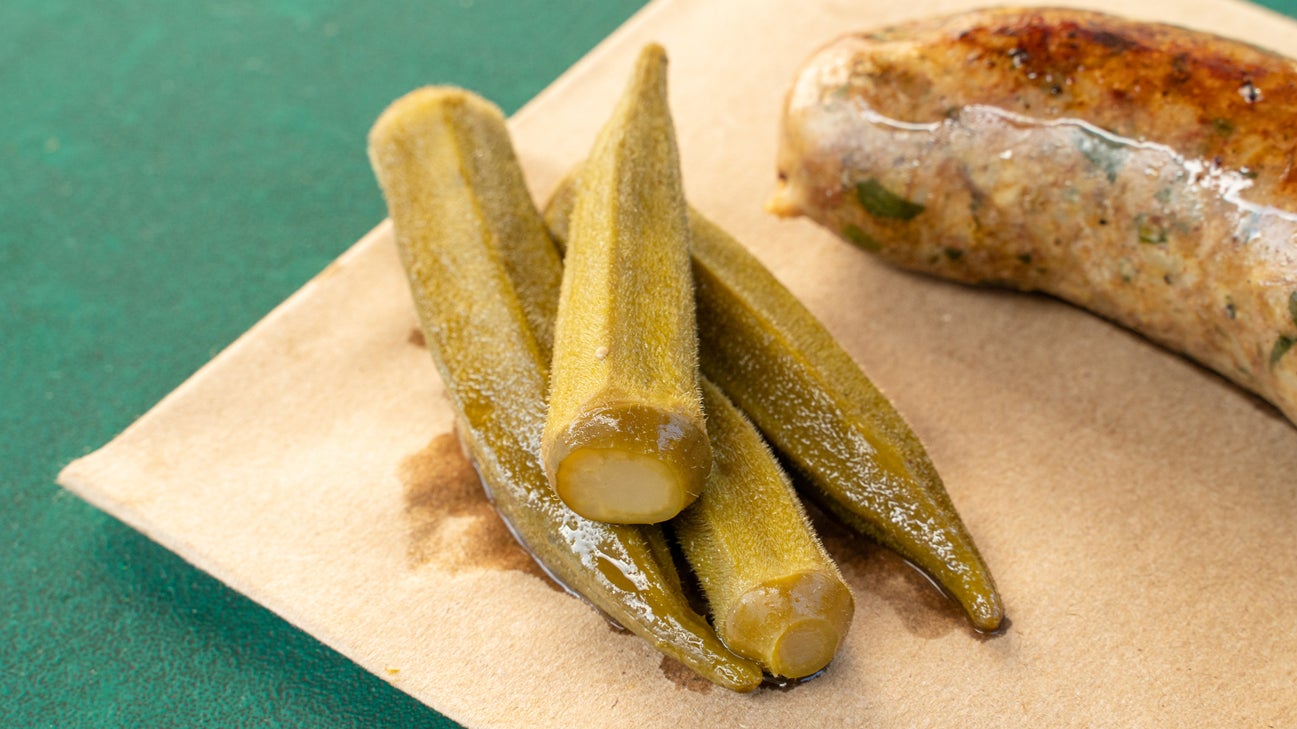
9 okra benefits worth a grocery trip
Okra — also nicknamed ladies’ fingers for its slender shape — is popular in gumbo and a fave Southern side dish when fried or pickled. If you’re not already munching on okra, here’s why you should give this veggie a chance.
1. Okra is a nutritional powerhouse
Yeah, yeah, we know *most* green veggies are chockablock with goodness, but okra is no exception.
If you’re looking for the straight facts on what you get from a cup of raw okra, here they are:
| Nutrition | Amount |
| calories | 33 |
| protein | 1.9 grams (g) |
| fat | 0.2 g |
| carbs | 7.5 g |
| fiber | 3.2 g |
| sugar | 1.5 g |
| vitamin K | 31.3 milligrams (mg) |
| potassium | 299 mg |
| vitamin C | 23 mg |
| magnesium | 57 mg |
| calcium | 82 mg |
| folate | 60 micrograms (mcg) |
| vitamin A | 36 mcg |
Bottom line: Okra offers essential nutrients like vitamins C, K, and A in a low calorie, low fat package. It also contains a fair bit of protein and fiber, which isn’t the case with all veggies.
2. Okra offers oodles of antioxidants
Like many other plants, okra is bursting with antioxidants. That’s a good thing since antioxidants beat back oxidative stress, which raises your risk of diabetes and other chronic disease.
Point is, that crispy grilled okra on your plate could fill your belly *and* keep your immune system in fighting form.
3. Your heart will love hearty okra
Research suggests that noshing on vegetables is a solid way to reduce your risk of heart disease. Thanks, plant-based antioxidants!
The mucilage (gel-like substance) in okra may also help the body expel excess cholesterol. In a 2014 study of mice, the ones that were fed okra powder eliminated more cholesterol in their poop than the other animals.
In a 2020 study of 60 patients with type 2 diabetes who ate okra powder for 8 weeks, they also had lower cholesterol.
Still, we need more studies to confirm this effect in humans.
4. Okra may reduce your risk of some cancers
Okra contains a protein called lectin, which was shown to slow tumor growth in a 2014 study of breast cancer cells. Keep in mind that this was a test-tube study — but the results are promising.
A recent research review further emphasized how okra’s antioxidants and lectin are a one-two punch against cancer. But a few paragraphs later, the scientists wrote that there just haven’t been enough studies on okra to say how much okra could slow cancer *or* how much you’d need to eat to reap that benefit.
5. Okra is great for pregnant peeps
Folate (aka folic acid) is a critical nutrient for healthy fetus development, and okra packs it in. That makes this veggie an excellent snack for pregnant folks.
Of course, the CDC says anyone with a period should ingest 400 micrograms per day. That would require more than 6 1/2 cups of raw okra, so it’s best to diversify your folate-rich food sources.
6. Okra contains bone-strengthening vitamin K
You might not need much folate, but everybody needs vitamin K. This essential nutrient helps your blood clot properly, protects your heart, and improves your bone health.
Experts recommend 120 micrograms of vitamin K for males and 90 micrograms for females each and every day. Just a cup of okra contains over 30 micrograms, so it’s enough to help you get dem bones on the road to long life and prosperity. 🖖
7. Okra helps fill up your fiber tank
Ah, fiber, you unsung hero. It keeps your gut clean, helps you poop, and even reduces inflammation. If you’re trying to increase your intake, 1 cup of okra contains 3 grams of fiber.
FYI, men need about 38 grams of fiber a day and women need 25 grams. So, you’re not going to go No. 2 because of okra alone, but it’s still a good source of fiber.
8. Okra might help squash high blood sugar
Munching on okra has been linked to stable blood sugar, but the research is slim, older, and done on animals. #WompWomp
Scientists think the nutrients in okra could help prevent your body from absorbing too much sugar during digestion. Specifically, research shows okra’s fiber content could help stabilize blood sugar.
If that’s the case, this veggie could be a bonus snack for folks with diabetes.
PSA: Don’t slam a plate of okra if you’re taking metformin for diabetes management. Older research on animals indicated that okra interferes with the way this med is absorbed.
9. Okra = an easy, peasy, stress-free side dish
One of the best things about okra is how easy it is to add to your meals. This veggie can be added to most soups or stews. Plus, it’s a stellar side dish when served alone.
If it’s your first time buying okra, know that there are three forms:
- Dried. Dry, powdered okra can be used in place of egg whites or to thicken sauces or soups.
- Seeds. Yep, okra seeds are edible! Snack on them roasted or grind them up to zhuzh up dishes with a little sprinkle of seeds.
- Fresh. Wet okra can be a bit, erm, slimy. You either love it or hate it. But the secret to tender, un-gummy okra is to cook it whole in the pod.
- Pickled. Just like cucumbers, adding some okra to a jar with vinegar and spices will give you a pickled product.
If it’s your first time cooking okra, know that there are endless ways to dish up this Southern beauty.
How to eat more okra
Beyond the Southern U.S., Okra is also enjoyed all over the world.
Wanna incorporate more okra into your diet? Here are a few tasty recipes to try:
- pickled okra
- Japanese okra salad
- Southern fried okra
- Mediterranean-style okra
- vegan Ghanaian okra stew
- Kurkuri bhindi (Indian fried okra)
- chicken, shrimp, and okra gumbo
Are there any benefits of eating okra every day?
If you love the taste and texture of okra, there’s no reason you can’t make it your daily veggie of choice. However, there’s no specific benefit to eating okra daily versus weekly.
Okra is also high in oxalates, which means that eating a lot of it *might* raise your risk of recurrent kidney stones.
tl;dr
- Okra, also known as ladies’ fingers, is a fuzzy green vegetable filled with seeds.
- Like many other vegetables, okra is full of antioxidants, vitamins, and minerals.
- Okra’s nutrients make it a healthy snack choice whether you’re concerned about heart, bone, or digestive health. Its folate content also makes it super beneficial for pregnant people.
- You can enjoy okra pickle, roasted, fried, or chopped into a veggie stew or gumbo.
from Greatist Health RSS Feed https://bit.ly/2ZG5w3K
5 Benefits of Sliding Ginseng into Your Skin Care Routine
Ginseng may seem like the brand-new buzzword of skin care, but ginseng has been a K-beauty staple for generations.
Here’s why this slow-growing root just might be the perfect ingredient for a fast-acting glow-up.
What are the top ginseng benefits for skin?
Ginseng stans believe it blesses their skin with a host of benefits, including:
- reducing fine lines and wrinkles
- banishing dullness
- reducing redness
- balancing oil
- making skin glow
It’s not all hype, either — some research supports these claims.
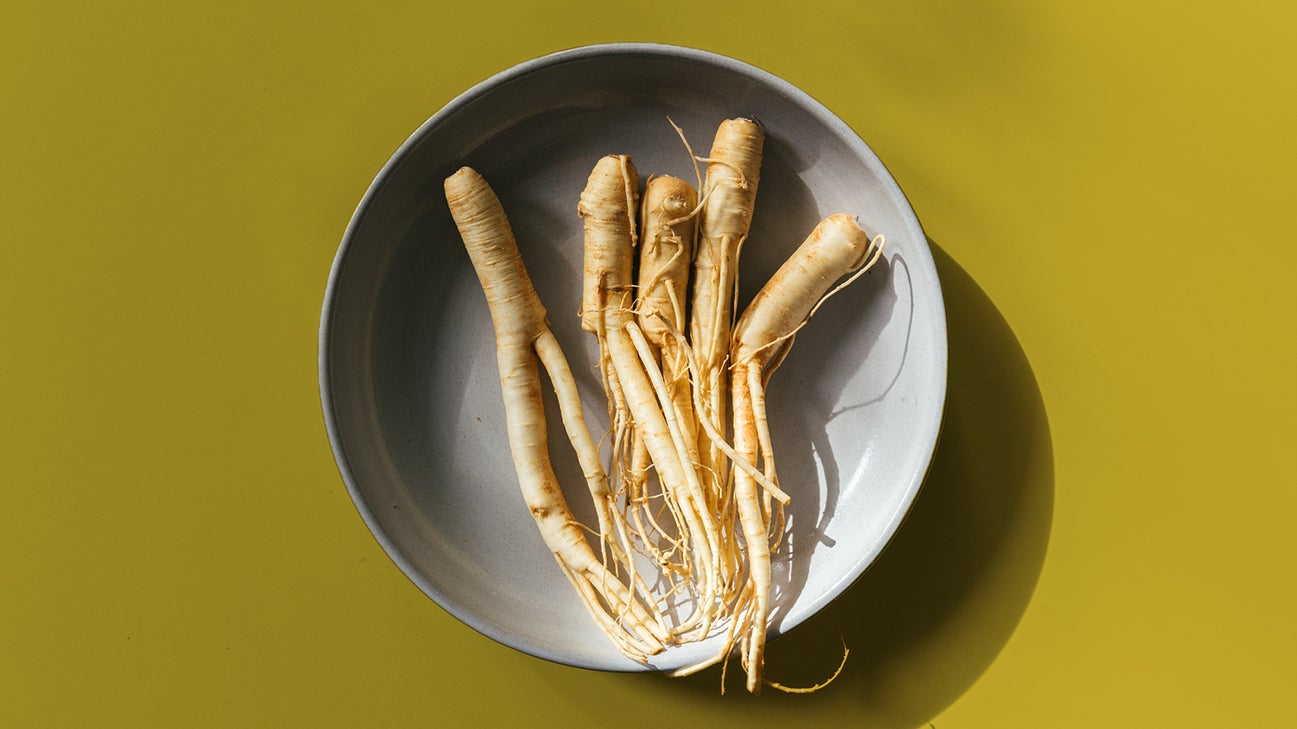
WTF is ginseng, anyway?
Before all the K-beauty and influencer rage, Asian ginseng was a core part of traditional medicine in East Asian countries for thousands of years. It’s native to places like China, Korea, and Siberia.
Typically used in the dried form of the root, it was thought to provide a number of benefits, from treating disease to serving as an aphrodisiac, stimulant, and anti-diabetes agent. It was also commonly used to treat bruises, boils, swelling, sores, and other skin conditions. (💫The more you know.)
In the past 3 decades, it’s become one of the most popular herbs in the world.
So, is ginseng good for your skin?
These days, ginseng is often a standout ingredient in skin care products like sheet masks, eye creams, and serums.
According to a 2017 review, its key benefits for the skin include:
- reducing signs of aging
- anti-inflammation
- anti-oxidation
- skin protection
Rich in vitamins and minerals, it’s considered suitable for all skin types. Its active components, ginsenosides, may be responsible for revitalizing and reactivating skin cells in particular.
Ginseng skin benefits
Blur fine lines and wrinkles
Wrinkles might be adorable on pugs and grandparents, but not everyone loves them on their *own* face.
Ginseng can help. It boosts circulation in blood vessels, potentially ramping up collagen synthesis and firming the skin. Two clinical trials (one from 2015 that used topical ginseng and another from 2009 that used oral red ginseng) concluded that ginseng extract diminished the appearance of wrinkles.
According to 2017 research, Ginseng extract may also boost skin’s hydration, helping to prevent the formation of new lines down the road.
Banish dullness
The zing in ginseng has coffee-like energizing properties. (For that reason, ginseng is one of the most common ingredients in energy drinks.)
Along with jolting you awake, slathering on some ginseng may wake up your face. While the research on this still remains spotty, a little topical ginseng may brighten your complexion and keep dullness at bay.
Balance oil
Everyone loves a natural glow — not so much a shiny, oily slick.
Whether your skin’s on the oily or drier side, ginseng’s antioxidant and moisture-retention properties just might help.
Bye, bye redness
Tired of waking up with inflamed, puffy skin?
According to 2013 research, ginseng has anti-inflammatory and antioxidant properties that may help alleviate redness, puffiness, and acne.
It may even help certain skin conditions. According to research from 2018 and 2011, Korean red ginseng extract improved symptoms like inflammation in people with eczema.
Get that glow
Ginseng just might put the G in your glow-up.
Ginseng’s antioxidant properties help protect the skin from environmental pollutants. Without this shield, pollutants may accumulate in the pores or stimulate melanocyte production, causing hyperpigmentation and other skin probs.
When your skin’s healthy and protected, just sit back, relax, and wait for the “OMG you’re glowing!” comments to roll in.
Add ginseng into your skin care routine: Top product picks
Since ginseng can be found in face cleansers, serums, and masks of all kinds, it’s an easy ingredient to slip into your regular routine.
You may just want to start with one of the following and then work your way up:
Face cleanser
Ginseng is ideal for cleansers due to its balancing, moisturizing properties.
Try this
Banila Co. is a K-beauty darling, and the nourishing version of their iconic Clean It Zero Balm may just be the perfect intro to ginseng extract you need. Heads up, though: It’s specially formulated for dry skin, so oilier types may want to pass on this.
Sheet mask
A ginseng sheet or face mask is the perfect way to replenish your skin when you feel like pampering yourself — without completely overhauling your current skin care routine.
Try this
Sulwhasoo offers super luxurious (and spendy!) sheet masks you may want to give a go if you’d like to target wrinkles in particular.
If you’re looking for something that won’t max out your card, consider this I’m From ginseng face mask instead.
Eye cream
Ginseng is a popular ingredient in eye creams due to its ability to fight that fateful morning puffiness.
Try this
This I’m From ginseng eye cream also contains hyaluronic acid and may tighten, strengthen, and brighten skin.
Face serum
Ginseng is an A+ ingredient for skin serums due to its ability to target a range of concerns, from fine lines to discoloration. Use it before you moisturize and after you tone.
Try this
With 5-star reviews across skin types, you might want to start by trying this I’m From ginseng serum, which promises to boost blood circulation, rejuvenate skin, and reduce fine lines and wrinkles.
Face cream
Ginseng is ideal for moisturizers due to its hydrating properties. Use it as the final step in your morning or nightly skin care routine.
Try this
The Origins Ginzing Oil-Free gel moisturizer quickly became a cult fave. Reviewers say the vegan formula offers grease-free hydration and radiance.
Other K-Beauty faves
Everyone knows K-beauty is the Kween of skin care. So, here are some more ideas to kickstart your K-beauty routine:
- green tea
- royal honey
- vitamin C
- hyaluronic acid
- yuza (aka yuja or yuzu)
- bamboo extract
- noni
- snail mucin
- centella asiatica
The takeaway
Research suggests that ginseng is a beneficial ingredient for skin. When applied topically, it may diminish the appearance of fine lines, reduce inflammation, boost hydration and protect the skin barrier.
Ginseng is appropriate for all skin types, but always patch test new products. Talk to a derm if you experience any issues.
from Greatist Health RSS Feed https://bit.ly/3EqhLAc
Breathe It In: 11 Eucalyptus Oil Benefits
Eucalyptus has some pretty sweet street cred in the essential oil world. Not only does it smell like a minty forest, it also has some pretty impressive health perks.
Here are the top benefits of adding eucalyptus oil to your life, plus safety tips for using this powerhouse oil the right way.
Eucalyptus oil benefits
Eucalyptus essential oil is versatile AF. It can be used as a topical solution or as aromatherapy. Here are 11 potential benefits of eucalyptus oil:
- healthier hair
- natural bug repellent
- antimicrobial properties
- may sooth dry skin
- calms cold sores
- pain reliever
- dental care
- boosts immune system
- clears congestion
- reduces anxiety
- kills lice
While research suggests there are health benefits, the FDA doesn’t monitor or regulate the purity or quality of essential oils. It’s important to talk with a healthcare professional before you begin using essential oils and be sure to research the quality of a brand’s products. Always do a patch test before trying a new essential oil.
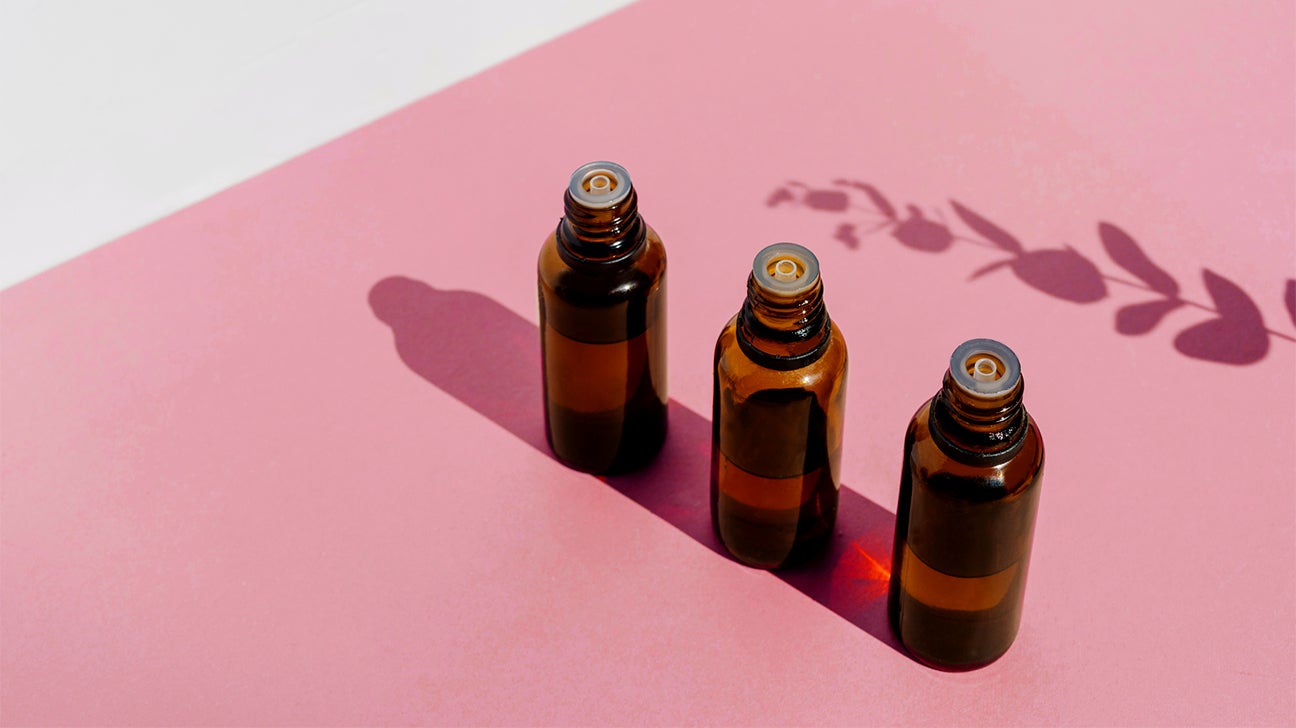
What is eucalyptus oil?
Eucalyptus essential oil is made from the dried, crushed, and distilled leaves of eucalyptus trees. The trees are part of the Myrtaceae plant family that are native to Australia (hello, cute koalas munching on eucalyptus), but they can now be found all over the world.
There are a few varieties of eucalyptus trees used to make the oil, including lemon eucalyptus tress. These trees are also used to make oil of lemon eucalyptus (OLE). This is technically different than your usual eucalyptus essential oil because it’s combined with para-menthane-3,8-diol (PMD) for extra power against pests like mosquitos and ticks.
11 eucalyptus oil benefits
1. Healthier hair
Eucalyptus oil has some pretty dope herbicidal, antifungal, and antimicrobial properties. That means it might help your hair and scalp health. Some folks think it can stimulate hair growth too, but we need more research to show if it can really turn you into Rapunzel.
There’s also a chance eucalyptus can help you ditch your dandruff. In a 2018 study, 34 peeps were given a scalp lotion that contained eucalyptus leaf extract and synthetic ceramide. It helped reduce scalp itchiness, redness, scaliness, and dryness. But despite positive findings, the study’s small sample size doesn’t necessarily prove it works.
2. Natural bug repellent
Eucalyptus oil contains eucalyptol, a natural insect repellent. Studies show it can ward off mosquitos and other annoying blood suckers. Pro tip: You can combine it with other essential oils to make it more effective.
Oil of lemon eucalyptus (OLE) can also provide long-lasting protection, according to the Centers of Disease Control and Prevention (CDC).
3. Antimicrobial properties
A 2016 study found that essential oil made from Eucalyptus camaldulensis — a plant in the Eucalyptus family — may help antibiotics work better against multi-drug resistant bacteria.
Another study found that eucalyptus oil can curb pathogenic bacteria in the upper respiratory tract. This includes Haemophilus influenzae, which has been linked to lots of different infections including pneumonia, meningitis, and cellulitis.
4. May soothe dry skin
Topical eucalyptus leaf extract might help boost ceramide production. These fatty acids help your skin maintain its protective barrier and retain moisture. This can be extra useful if you have skin or a condition like psoriasis or atopic dermatitis.
5. Calms cold sores
Thanks to its anti-inflammatory properties, eucalyptus might help ease herpes symptoms. But don’t put essential oil directly on a cold sore! Instead, find a balm or ointment that has eucalyptus as an active ingredient.
FYI: Eucalyptus oil can’t cure herpes. Your doc can give you some solid options to keep outbreaks under control though.
6. Pain reliever
Lots of over-the-counter (OTC) pain creams for rheumatoid arthritis and osteoarthritis contain eucalyptus essential oil. And for good reason! There’s a chance it can help reduce swelling, inflammation, and discomfort.
A 2013 study found that inhaling eucalyptus essential oil reduced pain and blood pressure in folks who underwent total knee replacement surgery.
7. Dental care
Eucalyptus oil might help keep the cavity creeps away. Its antibacterial properties can reduce your risk of tooth decay. One older study also found that eucalyptus extract in chewing gum can promote gum health.
Breath bonus: Since eucalyptus can prevent plaque buildup, it might improve bad breath.
8. Boost immune system
Eucalyptus oil might help your immune system, according to an older 2008 study. Researchers found that the oil helped boost phagocytic response in rats. Psst. That means it helped the immune system destroy foreign particles like bacteria. Keep in mind, we need more proof in humans.
9. Clear congestion
Eucalyptus might come in clutch if you have a case of the sniffles. Some studies suggest it can help relieve cold symptoms like nasal congestion. Research also shows it can expand the bronchioles and bronchi of your lungs, which is good news if you have asthma or rhinosinusitis.
10. Reduces anxiety
Some research shows that eucalyptus oil helps decrease activity in your sympathetic nervous system (aka the stress response system). This might promote relaxation and reduce stress.
A 2014 study also found that inhaling eucalyptus oil helped reduce anxiety in folks who were about to have surgery.
11. Kills lice
Eucalyptus oil might help send those lousy louses packing. In one randomized study, eucalyptus oil was twice as effective as another head lice treatment in curing head lice. But we still need more research to show its efficacy.
Eucalyptus oil side effects
Eucalyptus is generally safe to use on the skin. But some essential oils can be hazardous, according to the National Association for Holistic Aromatherapy (NAHA). That’s why it’s super important you stick to top-notch products from reputable sources. (Peep our guide to buying essential oils.)
You also have to be careful with the strength. The max dosage of diluted eucalyptus oil should be less than 5 percent. Anything stronger than that can irritate or burn the skin.
BTW: Pure eucalyptus essential oil is poisonous to take orally. A 3.5 milliliter dose (which is less than 1 teaspoon) can be fatal, according to the U.S. National Library of Medicine. Even a teeny-tiny dose can cause severe side effects like:
Note: You may want to avoid eucalyptus oil if you’re preggo or breastfeeding. There’s not enough research to show if it’s safe for your bébé.
Patch test PSA
Do a patch test before applying eucalyptus oil to your body. Apply a small amount behind your ear or on your forearm. If you don’t notice any irritation after 24 hours, you should be good to go. Just keep in mind, allergies can pop up over time.
How to use eucalyptus oil
Here’s how you can keep your eucalyptus oil use safe and effective.
For skin
You can find preblended eucalyptus essential oils online or in most health food stores. But you can also DIY your own at home. Just add a few drops of pure eucalyptus oil to a cup of carrier oil. Olive, coconut, or almond are all 10/10 choices. Then dab a bit on your skin. Just keep in mind, a little bit goes a long way!
P.S. Avoid your private parts and eyes. Trust us. That shiz burns 🔥.
For teeth
Eucalyptus can be found as an active ingredient in lots of tooth pastes, mouth rinses, and chewing gums. These products tend to be safer to use than actual eucalyptus essential oil because they reduce your risk of ingesting unsafe amounts.
In a diffuser
Add a few drops of eucalyptus essential oil to a steam bowl or diffuser. If you don’t have these, you can sprinkle a few drops on the side of your bath when you take a hot shower. The steam will help diffuse it.
As a bug repellent
Suck it, mosquitos! To make your own bug repellent, combine 1/2 cup of water, 1/2 cup of witch hazel, and up to 40 drops of eucalyptus essential oil. Pour the solution into a spray bottle and spritz it around an outdoor area. But be careful — it can be toxic for kiddos and pets.
The takeaway
Eucalyptus oil is made from the leaves of eucalyptus trees. It’s known to have herbicidal, antifungal, and antimicrobial properties. It can help soothe dry skin, reduce anxiety, ward off bugs, and relieve pain. But we still need more research to show all of the benefits are the real deal.
Reminder: Pure eucalyptus oil is poisonous and should NEVER be consumed. Make sure you talk with your doc before adding it to your routine.
from Greatist Health RSS Feed https://bit.ly/3jPKBlI
Popular Posts
-
Photo Edit by Wenzdai Figueroa Look around your local CrossFit affiliate or your fav athletes’ social feeds (hey, Rich Froning!) and you’...
-
from Greatist Health RSS Feed https://bit.ly/2X5PSdl
-
Sharing my review (so far!) of the Integrative Health Practitioner certification and my thoughts on the program. I’m so thrilled to be part...
